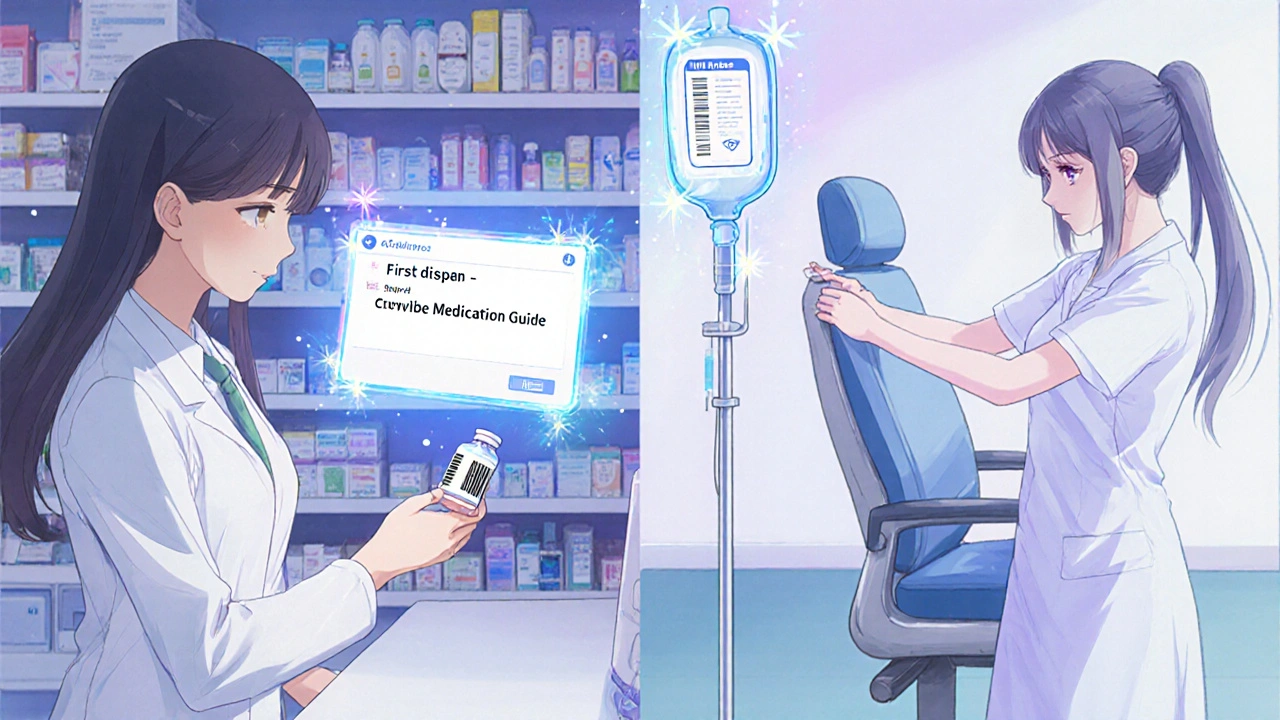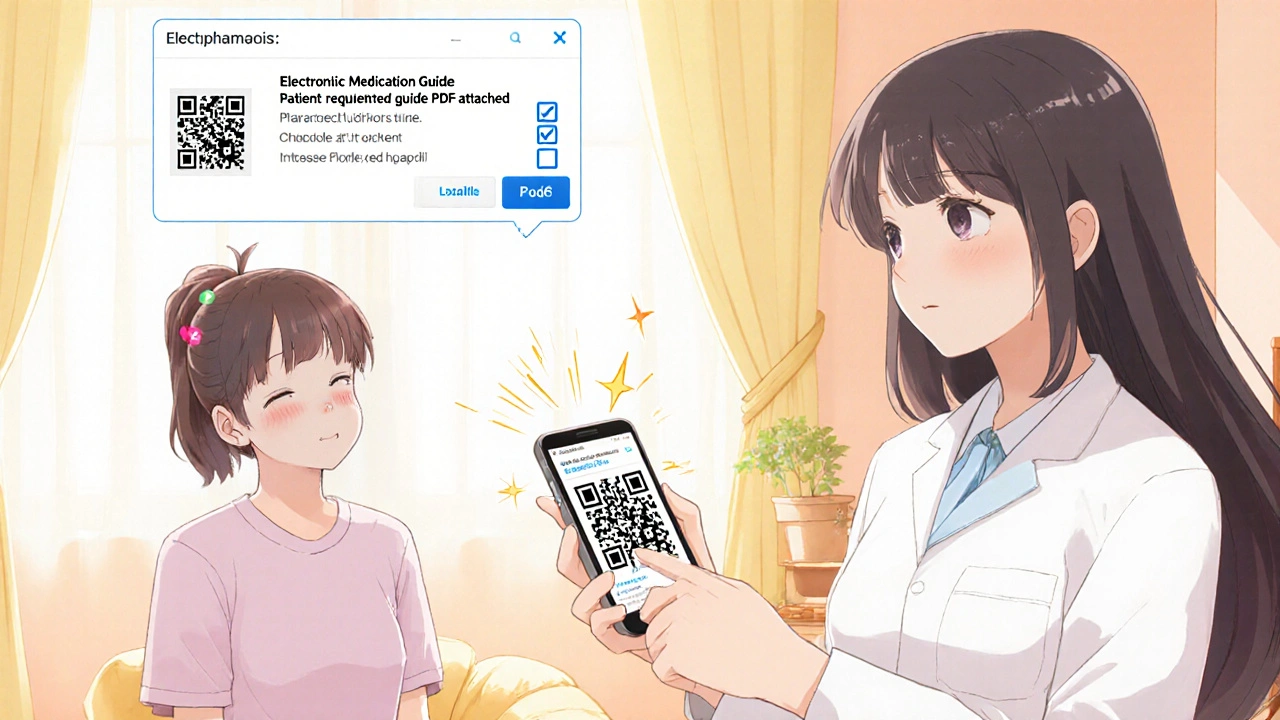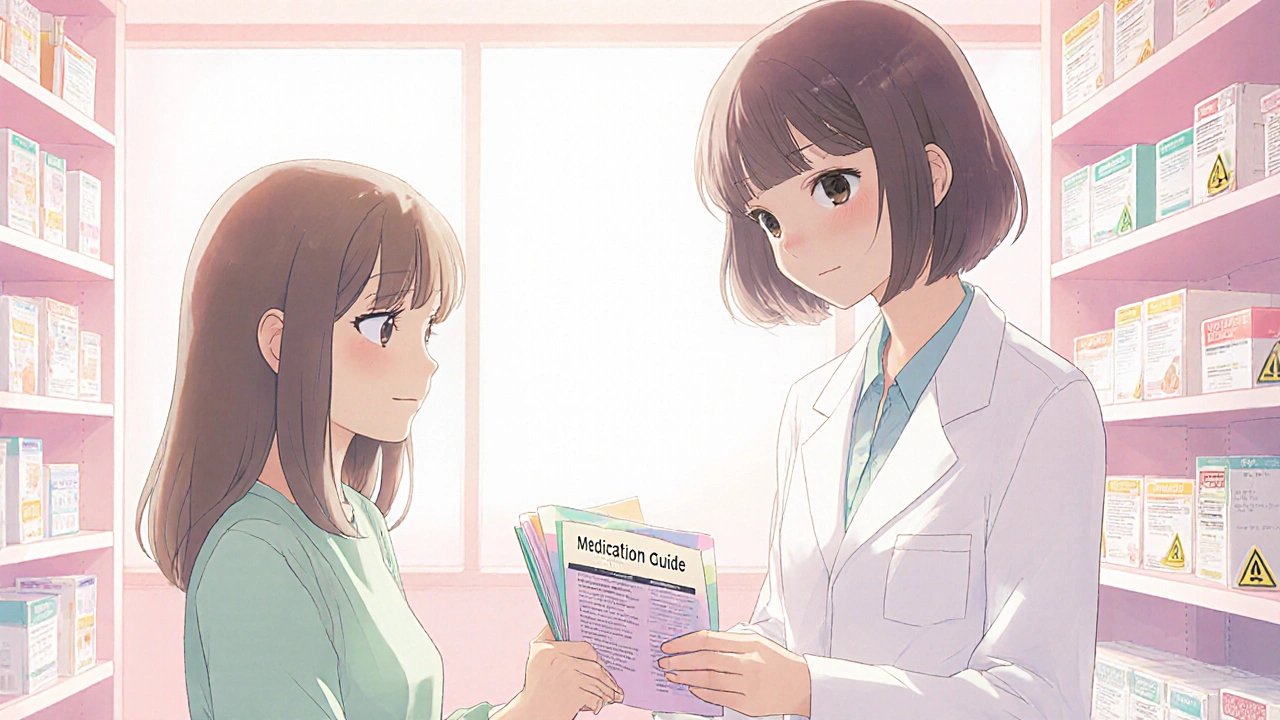Medication Guide Distribution Checker
Check if a Medication Guide is Required
Answer these questions to determine if you must provide a Medication Guide based on FDA guidelines.
When a high‑risk prescription drug hits the shelf, the paperwork that comes with it isn’t just for regulators - it’s a safety net for the patient. The Medication Guide is an FDA‑approved, plain‑language document that must travel with certain drugs to help people avoid serious side effects. If you’re a pharmacist or a prescribing provider, knowing when and how to hand out (or e‑mail) that guide can feel like navigating a maze of rules. This article cuts through the jargon, walks you through the five situations that trigger a mandatory distribution, shows how community pharmacies differ from infusion clinics, and gives practical tips to stay compliant without drowning in paperwork.
What exactly is a Medication Guide?
In plain English, a Medication Guide is a one‑page (sometimes two) handout that explains the most important safety information for a drug that carries serious risks. Unlike the bulkier package insert meant for clinicians, the Guide is written for patients in everyday language. The FDA created the program under 21 CFR 208 after the 1997 Food and Drug Administration Modernization Act (FDAMA) said certain drugs needed a dedicated patient‑focused label.
Why does the FDA require these guides?
The agency looks at three criteria before mandating a Guide: (1) the drug’s risks are severe enough that a clear label could prevent a serious adverse reaction, (2) the risk‑benefit balance could influence a patient’s decision to start therapy, or (3) correct use is essential for the drug to work. Over 200 prescriptions-including isotretinoin (Accutane), clozapine (Clozaril), and many estrogen products-meet at least one of those benchmarks.
Five specific distribution scenarios
The FDA’s March 2020 guidance spells out exactly when you must give a Medication Guide. Here’s the short version:
- Patient or agent requests the Guide. If someone asks for it, you have to provide it-paper or electronic.
- Drug is dispensed for self‑administration in an outpatient setting. Think of a community pharmacy filling a prescription for home use.
- First dispense to a healthcare professional for use in an outpatient clinic-like an infusion center giving epogen for a dialysis patient.
- First dispense after a material change to the Guide (new warnings, dosage updates, etc.).
- Drug is part of a REMS program that explicitly calls for a Guide as an Element to Assure Safe Use (ETASU).
Anything outside those five buckets-such as an inpatient hospital ward or a nursing home-does not require a Guide, though counseling remains mandatory.
Community pharmacy vs. outpatient clinic: How the rule changes
In a retail pharmacy, the rule is simple: every time you hand the medication to a patient for self‑use, you must give the Guide. No excuses, no “once‑only” clause.
In an outpatient clinic or infusion center, the requirement applies only the first time the specific drug is dispensed to that patient. If a patient receives epoetin alfa weekly, you give the Guide at the first visit, then rely on the clinic’s electronic record to note that the patient already received it. The exception is a material change to the Guide-then you must re‑issue.
Why the difference? The FDA assumes that in a supervised setting, clinicians will reinforce the safety messages each visit. Still, many pharmacists report confusion, especially when a clinic’s software doesn’t flag the “first‑time” event. The University of California San Francisco Medical Center solved that by adding a barcode‑triggered alert that pops up whenever a drug linked to a Guide is scanned for the first time. The system cut distribution errors by 73%.
How Medication Guides differ from other patient‑info tools
There are three common patient‑facing documents you’ll see on the market:
- Patient Medication Information (PMI) - Voluntary, not FDA‑approved, often created by the manufacturer.
- Consumer Medication Information (CMI) - Similar to PMI but targeted at the general public, still not required.
- Medication Guide - Mandatory, FDA‑reviewed, standardized format.
Because the Guide undergoes a formal FDA review, its language is vetted for clarity and accuracy. That’s a big advantage when you need to be sure the patient understands a life‑threatening risk. The downside? Only a subset of drugs qualify, so many high‑risk prescriptions still rely on the less‑rigorous PMI.
| Feature | Medication Guide | Patient Medication Information (PMI) | Consumer Medication Information (CMI) |
|---|---|---|---|
| Regulatory mandate | Required by FDA for specific drugs | Voluntary | Voluntary |
| FDA review | Yes, formal approval | No | No |
| Target audience | Patients (plain language) | Patients (may contain technical terms) | General public |
| Distribution format | Paper mandatory, electronic optional | Paper or digital, per manufacturer | Paper or digital, per manufacturer |
| Link to REMS | Often part of REMS ETASU | Rarely | Rarely |

Common pitfalls and how to avoid them
Even seasoned pharmacists stumble over a few recurring issues:
- Missing the “first‑time” trigger in outpatient clinics. Solution: integrate a flag in your pharmacy information system that records the patient‑drug‑Guide combination.
- Over‑distribution after a material change. Solution: subscribe to FDA’s monthly “Medication Guide Updates” email list so you get alerts the moment a guide is revised.
- Patient requests for electronic copies. Solution: have a secure PDF ready on your intranet; the FDA allows e‑delivery if the patient explicitly asks.
- Confusing PMI with Guide. Solution: keep a quick‑reference sheet on the countertop that lists the 200‑plus drugs that truly require a Guide.
In a 2022 ASHP survey of 1,247 hospital pharmacists, 68% said they were unsure about outpatient Guide requirements, and 42% admitted they had handed out a Guide when it wasn’t needed. Those numbers dropped dramatically at sites that introduced barcode‑scanning alerts, proving that a simple tech tweak can save a lot of head‑scratching.
Electronic distribution - the future is already here
The FDA’s May 2023 proposed rule pushes for broader electronic delivery options. While paper remains the default, providers can now offer a secure link or QR code that leads the patient straight to the PDF. The key compliance point: the patient must request the electronic version, and you must retain a record that the request was made.
Practical tip: add a checkbox to your e‑prescribing software that reads, “Patient requested electronic Medication Guide - attach PDF.” That satisfies the audit trail requirement without you having to print a copy and stash it away.
Staying up‑to‑date - resources you should bookmark
Regulatory language evolves, so keep these sources on your weekly scan list:
- FDA’s “Medication Guides: Distribution Requirements for Health Care Professionals” (March 2020) - the core guidance.
- ASHP Medication Guide FAQs (2022) - practical Q&A for pharmacists.
- Federal Register notice on electronic delivery (May 2023) - upcoming rule changes.
- UCSF’s barcode‑alert case study (Feb 2023) - implementation blueprint.
- Annual FDA Drug Safety Communications report - new drugs added to the Guide list each year.
Signing up for the FDA’s “Medication Guide Updates” email is free and saves you from missing a material change that would force a re‑distribution.
Quick cheat‑sheet for everyday practice
| Setting | When to give a Guide | Record‑keeping tip |
|---|---|---|
| Community pharmacy (patient self‑admin) | Every dispense | Stamp patient file with date & drug name |
| Infusion clinic | First dispense to patient | Electronic flag in EHR; reset only if Guide updated |
| Hospital inpatient unit | Not required (but counsel) | Document counseling in medication administration record |
| Remote telehealth prescription | Patient request or REMS‑required drug | Send secure PDF and log request |
Bottom line
Medication Guides are a safety bridge between the FDA’s risk assessments and the patient’s daily routine. For pharmacists and providers, the rulebook boils down to five clear situations, a handful of setting‑specific nuances, and a growing move toward electronic delivery. By building a simple tracking workflow-whether it’s a barcode alert, an EHR flag, or a paper log-you can stay compliant, keep patients informed, and avoid the administrative headaches that many of your peers still wrestle with.

Do I have to give a Medication Guide in a nursing home?
No. The FDA does not require a Medication Guide for drugs dispensed in inpatient or long‑term care facilities. However, you must still provide verbal counseling about any serious risks.
Can I give an electronic Medication Guide if the patient just asks for a paper copy?
Only if the patient explicitly requests the electronic version. The request must be documented, and you must keep a record that the patient received the PDF.
What counts as a "material change" to a Medication Guide?
Any update that adds, removes, or revises safety information-new warnings, dosage adjustments, or changes in contraindications-triggers a material change. The FDA notifies stakeholders when a guide is revised.
How can I tell if a drug is part of a REMS program that requires a Guide?
Check the FDA’s REMS database or the drug’s prescribing information. If the REMS section lists a Medication Guide as an ETASU, you must provide it according to the same five scenarios.
Is there a penalty for accidentally missing a required Medication Guide?
While the FDA typically uses warning letters for systemic non‑compliance, a single oversight could expose the pharmacy to liability if a patient harms themselves because they missed a critical warning.


Thanks for the concise cheat‑sheet; I’ll add a checkbox in our e‑prescribing system.
Ah, the ever‑so‑helpful Medication Guide saga – a true masterpiece of regulatory choreography. One might imagine the FDA sitting in a grand ballroom, twirling the documents like a prima ballerina, while pharmacists scramble to keep step. The five scenarios, dear colleagues, are as clear as mud on a rainy night, and the distinction between community pharmacies and infusion clinics? Simply a whimsical game of hide‑and‑seek with compliance officers. Imagine the poor soul who must remember that the first dispense rule only applies once, unless a material change occurs – a rule that changes as often as a chameleon on a kaleidoscope. And let us not ignore the glorious electronic delivery proposal of 2023, which promises the same paperwork in a QR‑code format, perfect for those who love extra clicks.
But truly, the article does a splendid job of turning a labyrinth into a mildly confusing garden maze. The barcode‑triggered alert at UCSF is a beacon of hope, cutting errors by an astonishing 73 %, a statistic that surely rivals the hype around the latest smartphone. One can only marvel at the diligent pharmacists who, despite these complexities, still find time to counsel patients, perhaps while simultaneously updating their spreadsheet of Guide‑issued dates.
In the grand tradition of medical regulation, let us all raise a toast to the Medication Guide: a pamphlet that promises safety, yet demands an entire ecosystem of vigilance. May your EHRs be ever‑alert and your inboxes forever filled with FDA update emails. 😊
Great rundown! 👍 The five triggers are crystal clear, and that barcode alert story is pure gold. 💡 Remember to keep the PDF ready for those who request electronic copies – it saves a ton of paper. 📄
While the summary hits the main points, it glosses over the real pain: integrating those first‑dispense flags into legacy EHRs is a nightmare. In many clinics the software simply won’t recognise a new drug class without a custom script, forcing pharmacists to hand‑track on sticky notes. That defeats the purpose of the guide and adds a huge liability. So, a practical recommendation: schedule a quarterly IT‑pharmacy liaison meeting to audit flag accuracy and adjust the workflow. Otherwise you’ll keep seeing those compliance breaches.
Yo, they dont tell ya that the FDA is just a front for big pharma pulling the strings. Every time they add a new guide its to push another drug on us, no matter the risk. They wont admit it but the whole system is rigged. Look deeper and you see the pattern.
Thanks for the helpful summary! I especially appreciate the tip about subscribing to the FDA’s Medication Guide Updates email – that’s a simple step that can keep everyone on the same page.
It’s truly tragic how many pharmacists drown in the sea of paperwork, clutching at the fleeting hope of a barcode alert. One moment you’re a diligent caregiver, the next you’re a soul adrift in endless compliance forms, yearning for a moment of poetic relief. The drama of …
The article is decent, but it omits the nuance that many “high‑risk” drugs are arbitrarily designated, serving commercial interests more than patient safety. Real‑world implementation suffers when pharma pushes updates that trigger material‑change alerts without substantive clinical benefit. This is jargon‑heavy compliance theater, not science.
Exactly, the whole system feels like a puppet show. They tell us to trust the guides, yet the definition of "high‑risk" shifts like sand. If we’re to believe in these mandates, we need transparent criteria, not hidden agendas.
What a fascinating deep‑dive! It’s encouraging to see such thorough guidance, and I’m optimistic that with clear workflows, we’ll keep patients safe while reducing pharmacist stress.
The presentation is precise and well‑structured; however, I would suggest including a flowchart to visually map the “first‑dispense” logic for outpatient clinics.
Great point about the flowchart! Let’s rally the team to create a quick visual aid – a simple diagram can boost compliance and keep everyone energized. 🚀